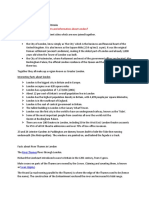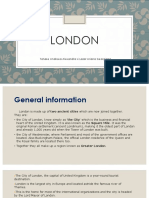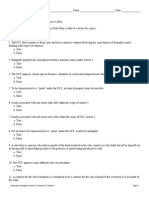0 ratings0% found this document useful (0 votes)
34 viewsThe South East
The South East
Uploaded by
TechArea GamingThe South-East region of England has a large population and wealthy economy centered around London. It is the most dominant and fastest growing region in England, though planning controls have restricted urban sprawl. The region has a varied economy including manufacturing, services, high-tech industries, and research facilities located outside of London. Major ports include Dover, Southampton, and facilities for international engineering, technology, defense, aerospace, IT, pharmaceutical and agriculture industries. The University of Surrey and University of Southampton are two universities located in the region.
Copyright:
© All Rights Reserved
Available Formats
Download as PDF, TXT or read online from Scribd
The South East
The South East
Uploaded by
TechArea Gaming0 ratings0% found this document useful (0 votes)
34 views30 pagesThe South-East region of England has a large population and wealthy economy centered around London. It is the most dominant and fastest growing region in England, though planning controls have restricted urban sprawl. The region has a varied economy including manufacturing, services, high-tech industries, and research facilities located outside of London. Major ports include Dover, Southampton, and facilities for international engineering, technology, defense, aerospace, IT, pharmaceutical and agriculture industries. The University of Surrey and University of Southampton are two universities located in the region.
Copyright
© © All Rights Reserved
Available Formats
PDF, TXT or read online from Scribd
Share this document
Did you find this document useful?
Is this content inappropriate?
The South-East region of England has a large population and wealthy economy centered around London. It is the most dominant and fastest growing region in England, though planning controls have restricted urban sprawl. The region has a varied economy including manufacturing, services, high-tech industries, and research facilities located outside of London. Major ports include Dover, Southampton, and facilities for international engineering, technology, defense, aerospace, IT, pharmaceutical and agriculture industries. The University of Surrey and University of Southampton are two universities located in the region.
Copyright:
© All Rights Reserved
Available Formats
Download as PDF, TXT or read online from Scribd
Download as pdf or txt
0 ratings0% found this document useful (0 votes)
34 views30 pagesThe South East
The South East
Uploaded by
TechArea GamingThe South-East region of England has a large population and wealthy economy centered around London. It is the most dominant and fastest growing region in England, though planning controls have restricted urban sprawl. The region has a varied economy including manufacturing, services, high-tech industries, and research facilities located outside of London. Major ports include Dover, Southampton, and facilities for international engineering, technology, defense, aerospace, IT, pharmaceutical and agriculture industries. The University of Surrey and University of Southampton are two universities located in the region.
Copyright:
© All Rights Reserved
Available Formats
Download as PDF, TXT or read online from Scribd
Download as pdf or txt
You are on page 1of 30
South-East England
The South East, centred on London, has a population and
wealth to match many nation-states. This is the dominant
area of England and the most rapidly growing one,
although planning controls such as greenbelts have
restricted the urban sprawl of London since the mid-20th
century.
While fully one-third of the South East is still devoted to
farming or horticulture, the region as a whole also has an
extensive range of manufacturing industry. With
improvements in the transportation systems, however,
nuclear and space research facilities, retailing, advertising,
high-technology industries, and some services have
moved to areas outside London, including Surrey,
Buckinghamshire, and Hertfordshire.
Industry
After London the South East has the
highest population density in the UK and is
often referred to as the engine of the British
economy. The region has the most varied
economy of all UK regions.
Industry
It is home to many international engineering
and technology companies, particularly in
the defence and aero industries. Other well-
developed sectors are IT, the pharmaceutical
industry, BioTech and agriculture (mainly
fruit). The Brighton area is a hotspot for the
creative sector, including a concentration of
interactive media.
The Port of Dover
The Port of Dover is a cross-channel ferry,
cruise terminal, maritime cargo and marina
facility situated in Dover, Kent, south-east
England.
The Port of Dover
Dover Castle
Dover Castle
This site was the primary defensive stronghold of England
from ancient Roman until modern times. For many
centuries English troops were garrisoned within these
walls, protecting the coast from any European menace.
This Roman lighthouse is a reminder that 2000 years ago
the Romans landed here and established their colony of
Britannia.
The Port of Southampton
The Port of Southampton is a passenger and
cargo port in the central part of the south coast of
England. The modern era in the history of the
Port of Southampton began when the first dock
was inaugurated in 1843. The port has been
owned and operated by Associated British Ports
since 1982, and is the busiest cruise terminal and
second largest container port in the UK.
The University of Surrey
The University of Surrey was established
on 9 September 1966 with the grant of its
Royal Charter, but its roots go back to a
late 19th-century concern to provide greater
access to further and higher education for
the poorer inhabitants of London.
The University of Surrey
On our Stag Hill campus, you’ll find a
number of attractive works of art, including
the Surrey Stag,
All The Gang Are Here,
the Geodesic Dome
the Spine.
The Stag denotes the medieval royal
hunting park on which the main
campus is built.
The Stag holding a key is taken from
the University coat of arms, and has
largely been turned into a silhouette.
All The Gang Are Here
The Geodesic Dome
The Spine
Other nearby works are Narcissus, which was
lent to the University by internationally-known
sculptor, William Pye. The visitors can also spot
three charming stainless steel fish sculptures
around campus: a fish on a bicycle and another
on a unicycle are located to the left of Senate
House, and the third can be seen riding a tricycle
outside the Library.
Narcissus
Based on the myth of Narcissus, forms are repeated
as if reflecting each other and the mirror, polished
stainless steel, reflects all that surrounds it.
The University of Southampton
The University of Southampton is a research
university in Southampton, England. The
university's origins date back to the founding of
the Hartley Institution in 1862. In 1902, the
Institution developed into the Hartley
University College, awarding degrees from the
University of London. On 29 April 1952, the
institution was granted full university status,
allowing it to award its own degrees.
Coat of arms- Significance
"The coat of arms signifies our strong connections
with our local community, and our commitment to
peace and advancement through learning."
Our motto strenuis ardua cedent means ‘the heights
yield to endeavour’, or, in other words 'hard work is
what leads to success'.
The University of Oxford
The University of Oxford
As the oldest university in the English-
speaking world, Oxford is a unique and
historic institution. There is no clear date of
foundation, but teaching existed at Oxford
in some form in 1096 and developed
rapidly from 1167, when Henry II banned
English students from attending the
University of Paris.
The University of Oxford
The University of Oxford
The coat of arms of the University of
Oxford depicts an open book with the
inscription Dominus Illuminatio Mea (Latin
for 'The Lord is my light') , surrounded by
three golden crowns.
You might also like
- Atestat Engleza TurismDocument17 pagesAtestat Engleza TurismDragoș GoiaNo ratings yet
- Form GST REG-06: (Amended)Document3 pagesForm GST REG-06: (Amended)aurelbullionNo ratings yet
- Warner Bros. Studio Tour London - The Making of Harry Potter AboutDocument2 pagesWarner Bros. Studio Tour London - The Making of Harry Potter AboutDMITRII GREC0% (1)
- Canada Toronto: L'artillerieDocument5 pagesCanada Toronto: L'artillerieala cuiumjuNo ratings yet
- Engle ZaDocument12 pagesEngle ZaRaluca RadaNo ratings yet
- LondonDocument3 pagesLondonCristina SaghinNo ratings yet
- Edinburgh London: The Old Town of EdinburghDocument6 pagesEdinburgh London: The Old Town of EdinburghXIván CFNo ratings yet
- VHAM - W2 - U2 - ScriptDocument6 pagesVHAM - W2 - U2 - ScriptLinh PhạmNo ratings yet
- Turismul in Marea BritanieDocument4 pagesTurismul in Marea BritaniecatasfNo ratings yet
- Largest Towns in The UKDocument4 pagesLargest Towns in The UKNatika NagyNo ratings yet
- LondonDocument2 pagesLondonthesofihoncharukNo ratings yet
- Interesting Facts About EnglandDocument6 pagesInteresting Facts About EnglandSALADRIANNo ratings yet
- London: Mariela Radeva and Mari DapchevaDocument15 pagesLondon: Mariela Radeva and Mari DapchevaMari DapchevaNo ratings yet
- EnglandDocument3 pagesEnglandTeodor RaresNo ratings yet
- EdinburghDocument19 pagesEdinburghLuisNo ratings yet
- Proiect UkDocument3 pagesProiect Ukvladut_cirstea100% (1)
- Oxford: Oxford Is A City in South Earth and TheDocument6 pagesOxford: Oxford Is A City in South Earth and TheLivia ElenaNo ratings yet
- London: - LandmarksDocument11 pagesLondon: - LandmarksJacxbJNo ratings yet
- Cambridge: Imperial War Museum Duxford (Commonly Referred To Simply As "Duxford") Is A Branch ofDocument3 pagesCambridge: Imperial War Museum Duxford (Commonly Referred To Simply As "Duxford") Is A Branch ofTeresa Sonja WagnerNo ratings yet
- United KingdomDocument5 pagesUnited KingdomPetrache Valentina RoxanaNo ratings yet
- England: Official Report of The European UnionDocument4 pagesEngland: Official Report of The European UnionIoana VisanescuNo ratings yet
- Visiting Cities in UK - LondonDocument9 pagesVisiting Cities in UK - Londonbalazslaszlo90No ratings yet
- 24. Great Britain + London.doc1Document7 pages24. Great Britain + London.doc1ladislavszoke3No ratings yet
- The United KingdonHistory & FactsDocument10 pagesThe United KingdonHistory & FactsDanielle WhitleyNo ratings yet
- Trip To London - TemplateDocument5 pagesTrip To London - TemplateIvan RafaelisNo ratings yet
- Презентация Лондон 28.11.2022Document15 pagesПрезентация Лондон 28.11.2022Алия ЖаналиеваNo ratings yet
- Refer atDocument5 pagesRefer atStoica MirelaNo ratings yet
- Official Report of The European UnionDocument3 pagesOfficial Report of The European UnionIoana VisanescuNo ratings yet
- BristolDocument1 pageBristolSlimydoomNo ratings yet
- CF 2012 Conference PackageDocument10 pagesCF 2012 Conference PackageAaron Julius M. LeccionesNo ratings yet
- LondonDocument3 pagesLondondasha hakaloNo ratings yet
- Tower BridgeDocument2 pagesTower BridgeMarioara CiobanuNo ratings yet
- LondonDocument1 pageLondonTomáš RybákNo ratings yet
- London: EnglandDocument15 pagesLondon: EnglandDénes OrsolyaNo ratings yet
- Australia and Briatain - PlacesDocument12 pagesAustralia and Briatain - PlacesRizielle MendozaNo ratings yet
- текст презентації ліпатовDocument21 pagesтекст презентації ліпатовInna ShynkarenkoNo ratings yet
- LondonDocument3 pagesLondonZsofiNo ratings yet
- England Birthplace of Shakespeare and The Beatles Is A Country Bordering The British Isles Bordering Scotland and WalesDocument4 pagesEngland Birthplace of Shakespeare and The Beatles Is A Country Bordering The British Isles Bordering Scotland and WalesMarthaNo ratings yet
- презентация БританияDocument18 pagesпрезентация БританияVozdyXNo ratings yet
- Culture and GastronomyDocument3 pagesCulture and GastronomyMireya HernandezNo ratings yet
- The Great Britain: Made By:angela JovanoskaDocument12 pagesThe Great Britain: Made By:angela JovanoskaGalina PetreskaNo ratings yet
- U.K'S Major Tourist Attractions: Buțescu Alexandra Ceacâru Andreea Ghiță Alexandra Vîrtineanu LilianaDocument12 pagesU.K'S Major Tourist Attractions: Buțescu Alexandra Ceacâru Andreea Ghiță Alexandra Vîrtineanu LilianaowlNo ratings yet
- Glimpses of LondonDocument3 pagesGlimpses of Londonshark777No ratings yet
- Lecturas de ComprensionDocument4 pagesLecturas de ComprensionMartha Elizabeth Lopez FloresNo ratings yet
- Docsity London Referat Po Inostrannym Yazykam Na Angliyskom YazykeDocument9 pagesDocsity London Referat Po Inostrannym Yazykam Na Angliyskom Yazykeamanbaevaa115No ratings yet
- EnglandDocument3 pagesEnglandsmejalenkaNo ratings yet
- The Most Famous Sights of LondonDocument11 pagesThe Most Famous Sights of LondonSzimonettaNo ratings yet
- London: University of Bihać Pedagogical Faculty English DepartmentDocument10 pagesLondon: University of Bihać Pedagogical Faculty English DepartmentTaliaNo ratings yet
- EnglandDocument8 pagesEnglandВіка ВольськаNo ratings yet
- ZZ 5Document5 pagesZZ 5Satheesh KumarNo ratings yet
- Zagadki o LondoneDocument3 pagesZagadki o LondoneGaukhar ZeinetullaNo ratings yet
- London's Attractions - CynthiaCDocument2 pagesLondon's Attractions - CynthiaCclcziprokNo ratings yet
- Edimburg HDocument20 pagesEdimburg HmariaNo ratings yet
- What Are Main Facts and Information About London?: River ThamesDocument10 pagesWhat Are Main Facts and Information About London?: River ThamesNam Luu Nguyen NhatNo ratings yet
- LondraDocument6 pagesLondrabalanescuionela8No ratings yet
- England ProjectDocument13 pagesEngland ProjectMiguel Leon TavizonNo ratings yet
- United Kingdom - Marea BritanieDocument29 pagesUnited Kingdom - Marea BritanieSALADRIANNo ratings yet
- My Dream DestinationDocument15 pagesMy Dream DestinationNadia Farheen0% (1)
- Tourist Places of EnglandDocument6 pagesTourist Places of EnglandShirley CastilloNo ratings yet
- London: Tanase Andreea Alexandra Si Lazar Ariana GeorgianaDocument9 pagesLondon: Tanase Andreea Alexandra Si Lazar Ariana GeorgianaDeea AndreeaNo ratings yet
- Ifsc CodesDocument24 pagesIfsc CodesMr VickNo ratings yet
- Chapter 1-Part 1: Half-Wave RectifiersDocument50 pagesChapter 1-Part 1: Half-Wave RectifiersWeehao SiowNo ratings yet
- AstrologyDocument11 pagesAstrologyVenzyl May MedranoNo ratings yet
- Microsoft Press Windows Phone 8 Development Internals Jun 2013Document1,046 pagesMicrosoft Press Windows Phone 8 Development Internals Jun 2013Sunilkumar DesarajuNo ratings yet
- SampleDocument2 pagesSampleMark Luis SedicolNo ratings yet
- Daftar PustakaDocument2 pagesDaftar PustakaHeri CahyonoNo ratings yet
- Modifications, New Features in The Brake System Model 374 375 930 932 933 976Document97 pagesModifications, New Features in The Brake System Model 374 375 930 932 933 976JuanMa Ag0% (1)
- Test Bank 20Document14 pagesTest Bank 20Ngân KimNo ratings yet
- PCI-Express ArchitectureDocument89 pagesPCI-Express ArchitectureAhmad F. Mahmood100% (1)
- Metals 14 00435Document19 pagesMetals 14 00435Anendra RestuNo ratings yet
- 4.the Rabin Karp AlgorithmDocument16 pages4.the Rabin Karp AlgorithmShubham TanejaNo ratings yet
- Lecture 2: Performance: CMPS 255 - Computer ArchitectureDocument26 pagesLecture 2: Performance: CMPS 255 - Computer ArchitecturesamahNo ratings yet
- Site Analysis-1Document1 pageSite Analysis-1megha madhuNo ratings yet
- II Pu Phy Blueprint For Mid Term Exam Mqp-3 24-25 KVVDocument2 pagesII Pu Phy Blueprint For Mid Term Exam Mqp-3 24-25 KVVshilpa146007No ratings yet
- Reppe Chemistry, Result in A Class of Materials Fond Commonly in Persdnal CareDocument7 pagesReppe Chemistry, Result in A Class of Materials Fond Commonly in Persdnal Careadamsamodra0% (1)
- DXN Testimonies On Wealth by Edwin MamarilDocument18 pagesDXN Testimonies On Wealth by Edwin MamarilEdwin MamarilNo ratings yet
- DBMSDocument26 pagesDBMSOperation ResearchNo ratings yet
- Revision Form 4 Fizik SPM 2020Document2 pagesRevision Form 4 Fizik SPM 2020WAN NOOR AZILAH BT WAN UMAR MoeNo ratings yet
- Shah JahanDocument8 pagesShah Jahananon-838010100% (1)
- Static Electricity Questions GRADE 8Document11 pagesStatic Electricity Questions GRADE 8boopNo ratings yet
- GST Knowledge5Document6 pagesGST Knowledge5sk mNo ratings yet
- S18B41.196.BIBM2.International Human Resource Management. JuliaAhumuzaDocument7 pagesS18B41.196.BIBM2.International Human Resource Management. JuliaAhumuzaJulia AhumuzaNo ratings yet
- Notes - Management AccountingDocument54 pagesNotes - Management Accountingbenjoel1209No ratings yet
- First Periodical Exam Photo HeaderDocument3 pagesFirst Periodical Exam Photo HeaderJes SaNo ratings yet
- Roasting Coffee (Transcript)Document5 pagesRoasting Coffee (Transcript)Limario ManobanNo ratings yet
- Larong PinoyDocument3 pagesLarong PinoyAlexie AlmohallasNo ratings yet
- Brain On Fire Unleashing Your Creative Superpowers - JoAnn Corley PDFDocument55 pagesBrain On Fire Unleashing Your Creative Superpowers - JoAnn Corley PDFjoselo60No ratings yet
- A1 What Is in Your Fridge SVDocument31 pagesA1 What Is in Your Fridge SVYevgeniyaNo ratings yet
- 9883511790ENUWADocument8 pages9883511790ENUWAhalexNo ratings yet
























































































